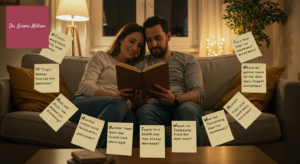Light therapy has gained popularity as a viable treatment for seasonal depression, often known as Seasonal Affective Disorder. Traditionally, bright light treatment has been used to treat exhaustion, low mood, and lethargy caused by decreased daylight hours in the winter. However, a growing body of evidence suggests that bright light therapy may provide benefits in addition to addressing seasonal sadness. As the study continues, scientists are looking into its potential applications for treating sorrow and anxiety in general, as well as other mental health issues.
The evolution of light therapy for depression, as well as its rising importance in the treatment of mental health issues, has prompted curiosity about its broader therapeutic potential. Beyond its recognized success in seasonal depression, many people are wondering if light therapy might help with depression that isn’t seasonal. Is light therapy for anxiety as effective in lowering emotional distress symptoms? This blog goes into the growing body of research and evidence on bright light therapy, its benefits, and the new frontiers where it is being investigated for treating various mental health issues.
How Does Bright Light Therapy Work?
Bright light therapy often entails being exposed to artificial light that simulates natural sunshine, with an intensity of 10,000 lux for a set length of time each day. The idea is to replicate sunshine, which helps regulate the body’s internal clock, also known as circadian rhythms. These cycles govern sleep, mood, and energy levels. Light therapy for depression works by compensating for the lower exposure to natural light that occurs during the fall and winter months, which frequently causes mood and sleep problems.
For many people, light therapy for depression is an effective technique to rebalance the circadian cycle, increasing mood and lowering depressive symptoms. In addition to treating seasonal depression, bright light treatment has shown potential in helping those with non-seasonal sadness. According to studies, light therapy can improve the efficacy of established depression therapies such as psychotherapy and medications. Furthermore, current research has looked into its efficacy in treating anxiety with light therapy.
Expanding the Benefits of Light Therapy for Mental Health
The use of light therapy for depression is increasingly being investigated in the treatment of generalized anxiety and chronic stress. Individuals with anxiety frequently report interrupted sleep habits and reduced energy levels, similar to those with seasonal depression. Researchers discovered that light treatment for anxiety can help lessen symptoms by regulating the sleep-wake cycle and increasing emotions of alertness and well-being. As a result, it is a potential supplemental treatment for those suffering from anxiety disorders who are both emotionally distressed and have difficulty sleeping.
Some studies have also suggested that light therapy could be a useful addition to treating depression and anxiety in patients who are already receiving standard treatments. Light therapy, by stabilizing circadian cycles, has the ability to improve sleep, boost mood, and make patients more open to other forms of treatment, such as couples therapy or marriage counseling. Light therapy for anxiety is a non-invasive and well-tolerated therapeutic option for people looking for an alternate or additional way to improve their emotional wellness
Moreover, red and blue light therapy is gaining traction as variations of light therapy target specific wavelengths to produce different therapeutic effects. Red light therapy is being investigated for its role in improving mood and decreasing inflammation, which may benefit people with chronic depression or anxiety. Similarly, blue light therapy, which has been shown to have a more significant impact on regulating the sleep-wake cycle, is also being studied for its potential to improve mental health by reducing depressive symptoms and anxiety levels.
Research and Evidence Behind Bright Light Therapy
Studies on the efficacy of bright light treatment continue to grow, with promising results. Bright light treatment has been found in studies to improve not only seasonal depression but also general depression, anxiety, and sleep difficulties. Some research even suggests that light treatment can help with sleep difficulties and persistent weariness. As a result, light therapy’s adaptability makes it an attractive option for people looking for effective, non-pharmacological treatments.
Does light therapy work for depression? The evidence strongly supports its use in treating seasonal depression, and emerging research indicates its utility in treating other forms of depression, such as chronic depression and bipolar disorder. The treatment is simple and accessible, offering a cost-effective alternative or complement to medications and psychotherapy. Additionally, light therapy can be used at home, making it convenient for individuals who may have difficulty attending in-person therapy sessions or seeking out more intensive treatments.
Furthermore, light therapy has been proposed as a potential treatment for people undergoing couples therapy or marriage counseling, especially if one partner is depressed or anxious. Improving an individual’s mood and emotional stability with light therapy can have a good impact on relationship dynamics, hence improving treatment session outcomes. This developing research offers hope for a more holistic approach to mental health treatment, with light therapy playing an important part in both individual and couple mental health care.
Is Light Therapy Safe?
One of the key benefits of light therapy for depression and anxiety is its safety and minimal side effects. Unlike pharmaceutical treatments, which may come with a range of side effects, light therapy is generally considered to be safe when used appropriately. Side effects are rare and often mild, including eye strain, headache, or mild nausea, which typically subside as the body adjusts to the treatment. It’s important, however, to consult a healthcare provider before starting light therapy, especially if you have a history of eye conditions or bipolar disorder.
When used correctly, bright light therapy is a low-risk, non-invasive treatment that can significantly improve mood, sleep patterns, and overall mental health. Given its proven track record for managing seasonal depression, many experts believe it could become an essential tool in treating various mental health conditions, including general anxiety, bipolar disorder, and even chronic stress.
Conclusion
Bright light therapy is quickly becoming recognized as a versatile and effective treatment for various mental health conditions, including seasonal depression, generalized depression, anxiety, and sleep disorders. With growing evidence supporting its benefits beyond just the winter months, more individuals are turning to light therapy as a non-pharmacological solution to manage their emotional well-being. Whether you’re seeking relief from seasonal depression, struggling with anxiety, or enhancing the effects of couples therapy, bright light therapy offers a promising option for individuals seeking improved mental health and a higher quality of life.
As light therapy continues to be studied, its potential for broader application in mental health treatment becomes clearer. This offers hope to those looking for practical, accessible, and non-invasive treatments. The combination of red light therapy and blue light therapy further expands the possibilities for those seeking holistic solutions to their mental health struggles, bringing new opportunities for healing and emotional growth. If you are considering therapies to enhance your well-being or improve relationship dynamics, seeking support from resources like Marriage Counseling CT NJ can offer guidance on integrating these therapies into a broader emotional and relational context.



